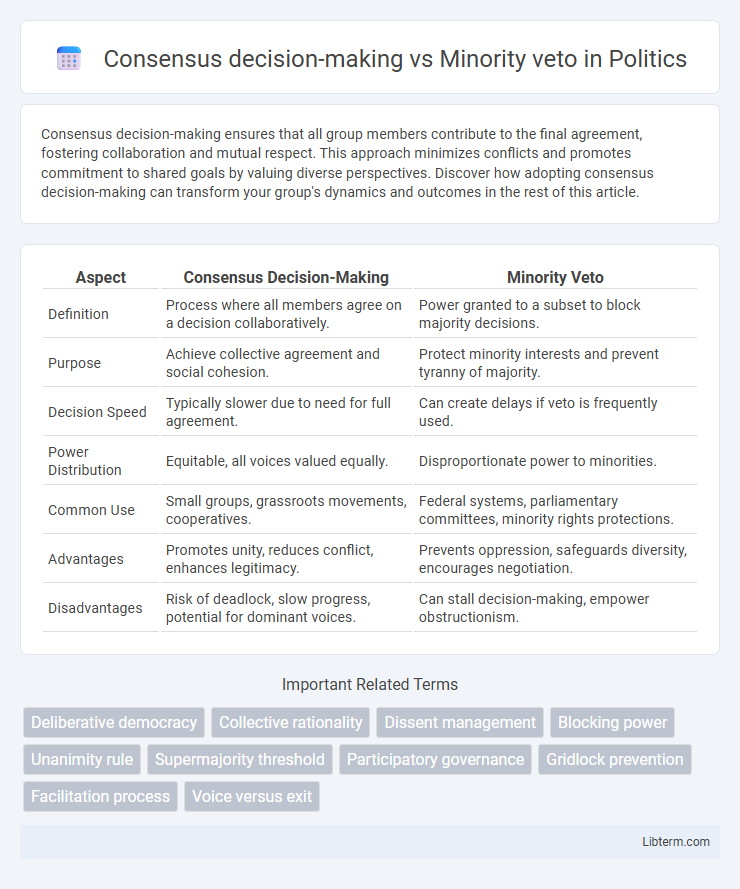Consensus decision-making ensures that all group members contribute to the final agreement, fostering collaboration and mutual respect. This approach minimizes conflicts and promotes commitment to shared goals by valuing diverse perspectives. Discover how adopting consensus decision-making can transform your group's dynamics and outcomes in the rest of this article.
Table of Comparison
| Aspect | Consensus Decision-Making | Minority Veto |
|---|---|---|
| Definition | Process where all members agree on a decision collaboratively. | Power granted to a subset to block majority decisions. |
| Purpose | Achieve collective agreement and social cohesion. | Protect minority interests and prevent tyranny of majority. |
| Decision Speed | Typically slower due to need for full agreement. | Can create delays if veto is frequently used. |
| Power Distribution | Equitable, all voices valued equally. | Disproportionate power to minorities. |
| Common Use | Small groups, grassroots movements, cooperatives. | Federal systems, parliamentary committees, minority rights protections. |
| Advantages | Promotes unity, reduces conflict, enhances legitimacy. | Prevents oppression, safeguards diversity, encourages negotiation. |
| Disadvantages | Risk of deadlock, slow progress, potential for dominant voices. | Can stall decision-making, empower obstructionism. |
Introduction to Consensus Decision-Making
Consensus decision-making emphasizes collaborative agreement where all participants actively contribute to shaping a solution that reflects collective interests, fostering inclusivity and shared ownership. This process seeks to integrate diverse perspectives, minimizing opposition by addressing concerns until a mutually acceptable outcome is achieved. In contrast, minority veto allows a smaller group to block decisions, which can lead to stalemates but also ensures protection of minority rights within group decision processes.
Understanding Minority Veto Power
Minority veto power allows a small group within a decision-making body to block proposals, ensuring their concerns are addressed even if the majority disagrees. This mechanism contrasts with consensus decision-making, which seeks agreement from all participants but may delay outcomes when minority views are strongly opposed. Understanding minority veto power highlights its role in protecting minority interests and preventing domination by the majority in collaborative governance settings.
Historical Context and Evolution
Consensus decision-making originated in indigenous and communal societies as a method to achieve collective agreement and maintain social harmony, while minority veto power evolved later in political systems to protect minority interests during decision processes. Historically, consensus models emphasized inclusive participation and mutual respect, whereas minority veto emerged as a formal mechanism to prevent majority tyranny in legislative bodies. Over time, both approaches have influenced modern governance, balancing collective unity with minority rights in democratic and organizational structures.
Key Principles of Consensus Approaches
Consensus decision-making prioritizes collaborative discussion and shared agreement, emphasizing inclusivity, mutual respect, and equal participation from all members. Key principles include seeking solutions acceptable to all participants, valuing diverse perspectives, and fostering cooperative problem-solving rather than competing interests. This approach contrasts with minority veto power, which allows a small group to block decisions without requiring full collective agreement, potentially hindering consensus-building efforts.
Mechanisms and Implications of Minority Veto
Minority veto in consensus decision-making grants a small group the power to block decisions, ensuring their concerns are addressed before agreement is reached. This mechanism promotes thorough deliberation and protection of minority rights but can also lead to decision paralysis or strategic obstruction. The implications include increased inclusivity and safeguards against majority dominance, balanced against potential inefficiencies and delays in organizational or group processes.
Advantages of Consensus in Group Decisions
Consensus decision-making enhances group cohesion by ensuring all members actively participate and agree, leading to higher commitment and satisfaction. It fosters diverse perspectives, promoting creative solutions and reducing the risk of conflicts or resentment often seen in minority veto scenarios. This inclusive approach can accelerate implementation and improve overall group performance by aligning goals and values.
Challenges and Limitations of Minority Veto
The minority veto in consensus decision-making often leads to prolonged stalemates, as a single participant can block initiatives despite majority support, hindering timely outcomes. This mechanism risks empowering uncooperative individuals to stall progress, creating inefficiencies and potential deadlock in group dynamics. Moreover, reliance on minority veto may discourage active participation and undermine collaborative trust, compromising overall decision quality and group cohesion.
Comparative Analysis: Efficiency and Inclusivity
Consensus decision-making fosters inclusivity by encouraging equal participation and seeking solutions acceptable to all members, often resulting in high group cohesion and shared ownership. Minority veto allows a small number of participants to block decisions, which can protect critical interests but may reduce efficiency by causing delays or stalemates. The balance between efficiency and inclusivity depends on group size and context; consensus suits collaborative environments requiring broad agreement, while minority veto provides safeguards in situations where minority rights must be preserved.
Real-World Applications and Case Studies
Consensus decision-making is widely applied in cooperative organizations like cooperatives and the Quaker community, where collaborative agreement fosters unity and shared responsibility. Minority veto power is notably used in international bodies such as the United Nations Security Council, enabling a small group to block decisions to protect critical interests and maintain checks and balances. Case studies of consensus in workplace democracy show increased employee satisfaction, while minority veto cases highlight the potential for stalemates in diplomatic negotiations.
Choosing the Right Model for Effective Governance
Consensus decision-making fosters collective agreement by incorporating diverse perspectives to build broad support, enhancing group cohesion and commitment. Minority veto allows a smaller faction to block decisions, protecting minority rights but potentially leading to stalemates and slowed processes. Selecting the appropriate governance model depends on organizational goals, valuing inclusivity for consensus or safeguarding minority interests through veto mechanisms to balance efficiency and fairness.
Consensus decision-making Infographic

 libterm.com
libterm.com